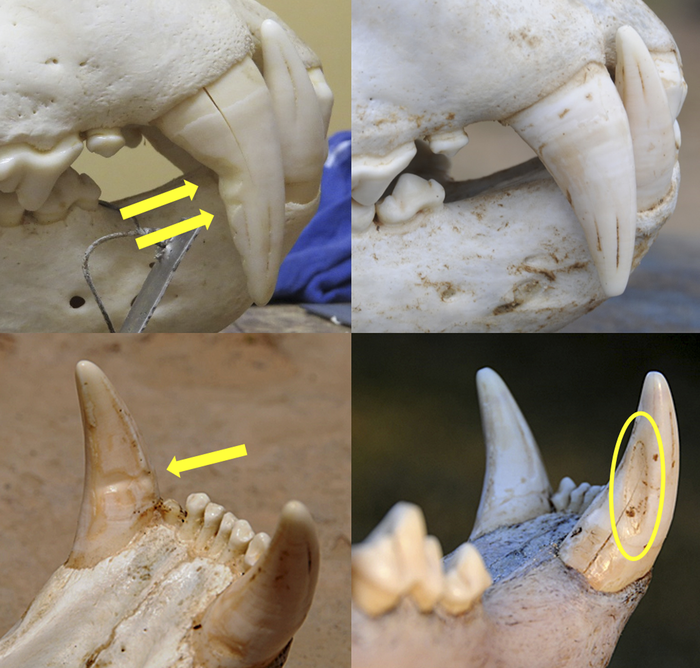The incidence of lion and leopard injuries caused by humans in Zambia is much higher than previously thought. Using a simple forensic examination technique, researchers found that injuries from entanglement in wire snares are present in 37% of lions and 22% of leopards in Zambia, while 27% of lions had shotgun pellets embedded in their skulls. Their method provides an opportunity to better monitor and quantify the number of large carnivores sustaining non-lethal injuries due to human activities including poaching and land protection.

Credit: Paula A. White
The incidence of lion and leopard injuries caused by humans in Zambia is much higher than previously thought. Using a simple forensic examination technique, researchers found that injuries from entanglement in wire snares are present in 37% of lions and 22% of leopards in Zambia, while 27% of lions had shotgun pellets embedded in their skulls. Their method provides an opportunity to better monitor and quantify the number of large carnivores sustaining non-lethal injuries due to human activities including poaching and land protection.
Today, only around 23,000 lions (Panthera leo) are left in the wild, and it is believed that leopards (Panthera pardus) are extinct in 23 of their 85 original habitat range countries.
The primary threat to African lions and leopards is human activity, such as poaching, encroaching into protected areas, conflicts with locals, and prey population decline due to the bushmeat trade.
In a new study published in Frontiers in Conservation Science, researchers studied the impacts of wire-snares and shotgun pellets on lions and leopards in Zambia via the forensic examination of skulls and teeth.
Wire snares and shotgun pellets
Wire-snares are traps used for bushmeat poaching and carnivore control. They pose a twofold threat to lions and leopards by reducing prey populations and unintentionally catching large carnivores.
Like snaring, shotgun pellets form a threat to large predators. Wildlife authorities and locals use shotguns with buckshot ammunition (made of lead pellets) to chase away predators. Serious injuries can occur by projectiles hitting the eyes and face of animals, and pellets can remain embedded in skulls, potentially resulting in lead poisoning.
“Mortality is the most common metric used to assess human impacts on wildlife,” explained Dr Paula White, of the University of California. “However, non-lethal injuries, that are often more cryptic, should also be considered when evaluating human impacts on wildlife.”
Using photographs to determine injuries
Effectively monitoring and quantifying non-lethal injury from snaring and shotgun pellets is difficult, and reported cases are likely an underestimation. White and her colleague Blaire Van Valkenburgh found a previously unused source of data to better quantify incidences of poaching and human-wildlife conflict.
“While investigating natural age-related tooth wear and damage and naturally-occurring skull injuries for another study, we detected abnormal tooth wear that was determined to be diagnostic of wire snare damage and old shotgun pellets embedded in skulls,” explained White.
“We realized that an individual’s history of past (non-lethal) injuries could be determined through simple forensic examination.”
The researchers used photographs of lion and leopard skulls to determine tooth damage from snaring and embedded shotgun pellets in skulls. The photographs were taken as part of a larger study on carnivores. They looked at samples of 112 lions and 45 leopards from two areas in Zambia, in particular the Luangwa Valley (LV) and the Greater Kafue ecosystem (GKE).
Sobering findings
The researchers found that, between LV and GKE, at least 37% of adult male lions (older than five years) and 22% of adult male leopards had been snared at some point in their lifetime. The incidence of snare damage was found more often in animals from GKE than in animals from LV.
Evidence of shotgun pellet injuries was only found among lions, with 27% of sampled individuals having shotgun pellets embedded into their skulls. Here too, GKE lions had a higher incidence than LV lions. Double injuries consisting of both snare damage and shotgun pellets were found in 16% of GKE lions and 7% of LV lions.
“The Luangwa Valley and the Greater Kafue ecosystem are two premier wildlife tourism areas in Zambia. Our findings indicate that even in these well-protected systems, poaching and human-wildlife conflict represent significant threats to large carnivores,” said White.
The researchers hope that their novel examination methods help improve regional monitoring and quantifying of non-lethal injuries in large carnivores.
“Despite the alarmingly high frequency of non-lethal injuries that we detected, we know that our findings are an underestimate,” concluded White. “Our methods may serve to improve future assessments of the total impacts that humans have on wildlife and provide a measure of the effectiveness of select conservation programs.”
Journal
Frontiers in Conservation Science
DOI
10.3389/fcosc.2022.803381




